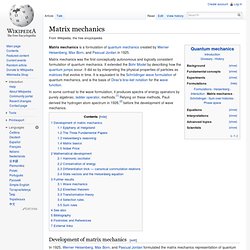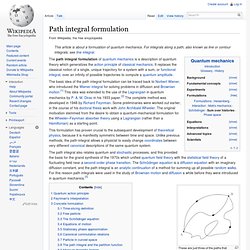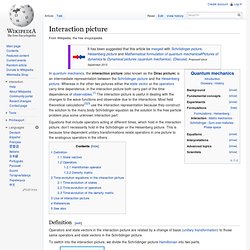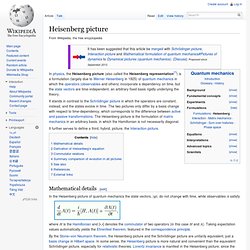

Matrix mechanics. Matrix mechanics is a formulation of quantum mechanics created by Werner Heisenberg, Max Born, and Pascual Jordan in 1925.

In some contrast to the wave formulation, it produces spectra of energy operators by purely algebraic, ladder operator, methods.[1] Relying on these methods, Pauli derived the hydrogen atom spectrum in 1926,[2] before the development of wave mechanics. Development of matrix mechanics[edit] In 1925, Werner Heisenberg, Max Born, and Pascual Jordan formulated the matrix mechanics representation of quantum mechanics. Epiphany at Helgoland[edit] In 1925 Werner Heisenberg was working in Göttingen on the problem of calculating the spectral lines of hydrogen. "It was about three o' clock at night when the final result of the calculation lay before me. The Three Fundamental Papers[edit] After Heisenberg returned to Göttingen, he showed Wolfgang Pauli his calculations, commenting at one point:[4] In the paper, Heisenberg formulated quantum theory without sharp electron orbits. W. Path integral formulation.
The path integral also relates quantum and stochastic processes, and this provided the basis for the grand synthesis of the 1970s which unified quantum field theory with the statistical field theory of a fluctuating field near a second-order phase transition.

The Schrödinger equation is a diffusion equation with an imaginary diffusion constant, and the path integral is an analytic continuation of a method for summing up all possible random walks. For this reason path integrals were used in the study of Brownian motion and diffusion a while before they were introduced in quantum mechanics.[3] These are just three of the paths that contribute to the quantum amplitude for a particle moving from point A at some time t0 to point B at some other time t1. Quantum action principle[edit] But the Hamiltonian in classical mechanics is derived from a Lagrangian, which is a more fundamental quantity considering special relativity. And where and the partial derivative now is with respect to p at fixed q. Interaction picture. Equations that include operators acting at different times, which hold in the interaction picture, don't necessarily hold in the Schrödinger or the Heisenberg picture.

This is because time-dependent unitary transformations relate operators in one picture to the analogous operators in the others. Definition[edit] Operators and state vectors in the interaction picture are related by a change of basis (unitary transformation) to those same operators and state vectors in the Schrödinger picture. Any possible choice of parts will yield a valid interaction picture; but in order for the interaction picture to be useful in simplifying the analysis of a problem, the parts will typically be chosen so that H0,S is well understood and exactly solvable, while H1,S contains some harder-to-analyze perturbation to this system. Heisenberg picture.
It stands in contrast to the Schrödinger picture in which the operators are constant, instead, and the states evolve in time.

The two pictures only differ by a basis change with respect to time-dependency, which corresponds to the difference between active and passive transformations. The Heisenberg picture is the formulation of matrix mechanics in an arbitrary basis, in which the Hamiltonian is not necessarily diagonal. It further serves to define a third, hybrid, picture, the Interaction picture. Mathematical details[edit] In the Heisenberg picture of quantum mechanics the state vectors, |ψ⟩, do not change with time, while observables A satisfy This approach also has a more direct similarity to classical physics: by simply replacing the commutator above by the Poisson bracket, the Heisenberg equation reduces to an equation in Hamiltonian mechanics. Derivation of Heisenberg's equation[edit] where H is the Hamiltonian and ħ is the reduced Planck constant.
It now follows that Thus which implies. Schrödinger picture. In physics, the Schrödinger picture (also called the Schrödinger representation[1]) is a formulation of quantum mechanics in which the state vectors evolve in time, but the operators (observables and others) are constant with respect to time.[2][3] This differs from the Heisenberg picture which keeps the states constant while the observables evolve in time, and from the interaction picture in which both the states and the observables evolve in time.

The Schrödinger and Heisenberg pictures are related as active and passive transformations and have the same measurement statistics. In the Schrödinger picture, the state of a system evolves with time. The evolution for a closed quantum system is brought about by a unitary operator, the time evolution operator. For time evolution from a state vector at time to a state vector , the time-evolution operator is commonly written , and one has where the exponent is evaluated via its Taylor series. Background[edit] and returns some other ket , or both.